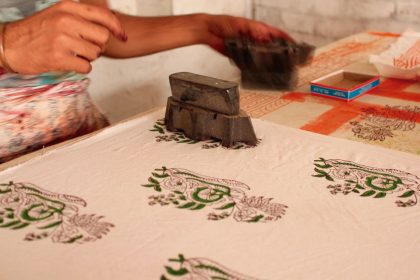
The stamping stamps is one of the oldest techniques for textile printing world. Used widely throughout East Asia, it has been native to China since ancient times as a method of printing on tissue and paper.
This technique was already used in the 7th century by the Chinese and was also very popular in India, where the cotton prints that popularized this practice on the European continent come from.
Stamp printing uses blocks of wood with different shapes and carved patterns in relief that are then impregnated with dye to be applied on fabrics. In Africa, pumpkin carved stamps, used in Europe until the end of the 18th century, were popular. Today the possibilities are endless and even stamps are used that were not originally intended to print on textiles, as is the case with those made for scrapbooking, but which with the appropriate inks and procedures, are very effective when stamping on. these materials.
Stamp printing has a long history. There are many different techniques, but essentially all of them are based on carving a material with a raised pattern that is covered in ink and transferred to fabric or paper. The carvings can be done in wood, linoleum or rubber. The stamps are first carefully prepared with a relief pattern that is carved out of the chosen material. For printing in several colors, different blocks are used, that is, one per color, playing to match the drawings or even sometimes overlapping them, producing different shades of color with the same impression.
Just let your imagination fly and choose the design you want to print and of course the fabric to be used. The stamps can be acrylic, wooden or even make custom stamps, such as those that can be made in a few minutes using eva rubber . When choosing the fabric to be printed, it is important to take into account some factors, especially to ensure that the pattern is not damaged when the fabric is washed. Composite textiles containing at least 50% cotton or natural fabrics are recommended.

Photos taken from: Google Images, Creative Commons License
Textile stamping with stamps is classic and has transcended time to be useful in different industries such as fashion. The steps to do so are simple and as long as they are followed properly, the results will be unbeatable.
It may seem like a manual and traditional process as it is extinct, but nothing is further from the truth. Stamping is one of the most common techniques even today in India, both accessories, garments and home textiles.
New Year, New Vibe: Refresh Your Home with the Magic of Hand Block Prints
December 26th, 2025Why Sustainable Home Décor Buyers in the UK Are Choosing Indian Textiles
December 24th, 2025Why British Homes Are Falling in Love With Handcrafted Indian Quilts
December 24th, 2025How to Create a Cozy Boho Home This Winter with Hand Block Prints
December 19th, 2025Why Hand Block Printed Patchwork Tote Bags Are the New Everyday Essential
December 12th, 2025